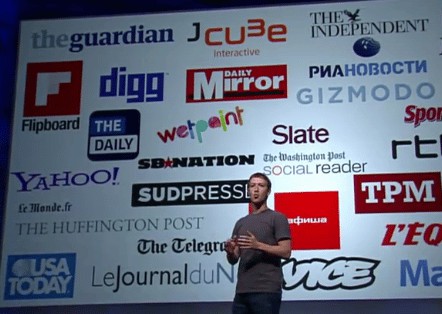
Two weeks in, some of Facebook’s new media partners are finding triple the listeners and a small uplift in readers from their new “frictionless” apps, paidContent is told. But how much do these gains really amount to… ?
-
Spotify, Facebook’s flagship partner, isn’t disclosing any actual effect on its user base, but it is thought to have grown. Feeding listened song titles in to Facebook users’ timelines has massively boosted the monthly active user count for Spotify’s Facebook app (distinct from its desktop or mobile apps), which also had existed prior to F8, to a record 5.7 million (source: AppData)…

- “Slacker’s new daily online listeners has nearly tripled,” the music service tells paidContent. “Our Facebook fan page has more than doubled – in large part, due to the (Facebook app) promo.” Slacker now has over 400,000 paying subscribers amongst 30 million users, but won’t say how much of that is attributed to Facebook, but the listener growth bodes well for conversion in a freemium environment.
- The Guardian, whose Facebook app pipes in to newsfeeds every story a reader readers within it, tells paidContent: “It’s too early to know but, since launch, the app has been installed by 129,000 Facebook users, who have generated over 611,000 story clicks.” That is 0.45 percent of the page impressions Guardian.co.uk clocked in an equivalent 11-day period, prior to F8, in August.
- To capitalise on the opportunity, Rdio and Mog recently aped Spotify by introducing free music as a taster for Facebook friends. But neither is disclosing just how many minutes or tracks it will give away – a sure sign they are hedging their bets against being deluged with free listening requests.
All of these metrics is likely to grow, as more Facebook users adopt the new apps and network effects kick in. For media services, being in the new shop window created by Facebook’s own sharing activity is clearly a great customer referral opportunity. That opportunity is to convert in to paying users the newcomers who come in through Facebook. If they can’t do that, the services supporting a heightened free user base without advertising could actually find themselves in a worse position.
But looking beyond the services’ own disclosures and in to Facebook data itself shows a different angle from the above. Though the monthly user count for Spotify’s Facebook app is massively up, its daily active user count plummeted by nearly a fifth in the seven days since Facebook’s new feature roll-outs…
What’s worse for Spotify, the key metric many regard as a barometer for Facebook app success (the ratio of daily to monthly active users) also fell in response to the new features, and is continuing to slide.
On this basis, Spotify’s Facebook app is now far less popular than it was at the start of the year – before F8 and before it launched in the U.S….
What’s going on? It seems floods of users have indeed been using Spotify-Facebook link, and Facebook has become a great way to sign up new users. But many users have also either pulled the plug on vomiting out listening habits to friends, or have simply scaled back their listening volume (perhaps to levels that are nevertheless higher than pre-F8) after an initial period of feverish curiosity.
The Guardian‘s Facebook app has this week been trumpeted as the week’s top gainer.
But curiously absent from this AppData data are all the other media apps, like Spotify itself. Apparently, this is because they are not considered “emerging” apps, likely because many of them already had rudimentary Facebook apps.
Reading Facebook app data, then, is interesting but problematic, and not nearly as enlightening as services’ disclosures about their actual user base.

